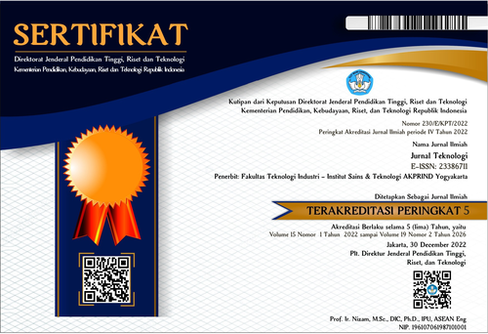Pengaruh Waktu Proses dan Ukuran Bahan terhadap Efektivitas Proses Maserasi Daun Strobilantes Cusia
DOI:
https://doi.org/10.34151/jurtek.v15i1.3570Keywords:
maceration, sibiru, strobilantes cusiaAbstract
Strobilanthes cusia is a herbaceous shrub that is a source of blue dye, grows well above an altitude of 1000 m. This plant is very easy to breed, and for the purposes of making this plant dye, it can be harvested every 3 months. The use of strobilantes cusia leaves as natural dyes has been managed by UMK Shibiru in the Ngadirejo area, Temanggung. The results in the form of pasta have been marketed to various regions and even abroad. Some of the products are directly used to dye fabrics to serve the needs of batik in various regions. The raw materials in the form of leaves and twigs are macerated using water, within three days. The effectiveness of the process can still be improved by examining the factors that influence the effectiveness of the maceration process. In this study, it was studied how the effect of material size and time on the effectiveness of the maceration process. The results showed that the smaller the size of the material and the greater the time used, the results obtained will be better, which was indicated by the intensity of the color of the extract produced. By using a UV-Vish Spectrophotometer, two colors were detected in the extract solution, namely blue with a wavelength of 409 nm and red with a wavelength of 678 nm. However, from further observations by observing the absorbance, it can be seen that the red content is smaller than the blue color. The best result in this study was the maceration process using a leaf size of 0.5 cm and a maceration time of 3 days. Under these conditions, maceration results were obtained with an absorbance value of 24,295 for the blue color with a wavelength of 409 and an absorbance value of 12,150 nm for the red color with a wavelength of 678 nm.
Downloads
References
Chairunnisa, S., Wartini, N. M., & Suhendra, L. (2019). Pengaruh Suhu dan Waktu Maserasi terhadap Karakteristik Ekstrak Daun Bidara (Ziziphus mauritiana L.) sebagai Sumber Saponin. Jurnal Rekayasa dan Manajemen Agroindustri ISSN, 2503, 488X.
Liau, BC, Jong, TT, Lee, MR dan Chen, SS (2007) Metode LC-APCI-MS Untuk Deteksi Dan Analisis Triptantrin, Nila, Dan Indirubin Dalam Daqin Gye Dan Banlangen. Jurnal Biologi Makasar 43, 34643.
Margaretta, S., S.W. Handayani., N. Indrawati, dan H. Hindarso. 2011. Ekstraksi senyawa fenolik Pandanus amaryllifolius Roxb. sebagai antioksidan alami. Jurnal Widya Teknik. 10(1):21-30.
Treybal. 1980. Mass-Transfer Operations. 3rd ed. McGraw-Hill International, Singapore.
Triyati, E. (1985). Spektrofotometer ultra-violet dan sinar tampak serta aplikasinya dalam oseanologi. Jurnal Oseana, X (1), 39-47.
Downloads
Published
How to Cite
Issue
Section
License
Copyright (c) 2022 Murni Yuniwati

This work is licensed under a Creative Commons Attribution 4.0 International License.
Jurnal Teknologi provides immediate open access to its content in order of making research freely available to the public to support a global exchange of knowledge. All articles published in this journal are free for everyone to read and download, under licence CC BY SA.
Benefits of open access for the author, include:
- Free access for all users worldwide.
- Authors retain copyright to their work.
- Increased visibility and readership.
- No spatial constraints.




















